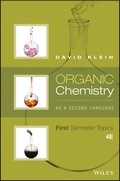
Interpretation:
The number of protons giving rise to each signal in the spectrum of a compound with molecular formula

Concept Introduction:
Integration is one of the characteristics of proton NMR spectrum which is the area under each signal. After acquiring a spectrum, a computer calculates the area under each signal, and then displays this area as a numerical value placed under the signal which is relative only.
In order to convert the integration values into useful information, a smallest number should be chosen and then all integration values should be divided by this number. If the numerical values are not whole numbers, then in order to arrive at whole numbers all the numbers should be multiplied by a suitable integer.
Want to see the full answer?
Check out a sample textbook solution
Chapter 3 Solutions
EBK ORGANIC CHEMISTRY AS A SECOND LANGU
- Calculate the degree of unsaturation (DU) for a molecule with the formula of C₂H, O. 10arrow_forwardIn a proton NMR spectrum, indicate the number of peaks and their multiplicity for the following compounds: CH3 - CH2 - CO - CH3 para-chloromethylbenzenearrow_forwardFor the following compound how many different signals would you see in the carbon NMR? (Assume that you can see them all.) 4 O 5 O 3 09 CO |arrow_forward
- The following molecule will give two signals in the proton (¹H) NMR. H₂C What is the ratio of the signal intensities for the two peaks? 2:2 O 3:1 3:2 CH₂ O 2:1arrow_forwardThe 1H NMR spectrum of 2-propen-1-ol is shown here. Indicate the protons in the molecule that are responsible for each of the signals in the spectrum.arrow_forwardThe following 1H NMR spectra are for four compounds, each with molecular formula of C6H12O2. Identify the compounds.arrow_forward
- A'H NMR spectrum is shown for a molecule with the molecular formula of CeH9Br. Draw the structure that best fits this data.arrow_forwardAre there signals that you can assign to specific protons in the molecule (labeled a-k)? Complete this column of the table. It may not be possible to assign each signal to a specific proton.arrow_forwardCompound 1 has molecular formula C7H16. It shows three signals in the 1H-NMR spectrum, one at 0.85 ppm, one at 1.02 ppm, and one at 1.62 ppm. The relative integrals of these three signals are 6, 1, and 1, respectively. Compound 2 has molecular formula C7H14. It shows three signals in the 1H-NMR spectrum, one at 0.98 ppm, one at 1.36 ppm, and one at 1.55 ppm. The relative integrals of these three signals are 3, 2, and 2, respectively. Propose structures for compounds 1 and 2, explaining how you reach your conclusion.arrow_forward
- The 13C NMR spectrum of a compound with molecular formula C7H16O, measured in CDCl3. Assign the carbons by putting the appropriate letter over each peak in the spectrumarrow_forward1Compound 1 has molecular formula C7H16. It shows three signals in the 1H-NMR spectrum, one at 0.85 ppm, one at 1.02 ppm, and one at 1.62 ppm. The relative integrals of these three signals are 6, 1, and 1, respectively. Compound 2 has molecular formula C7H14. It shows three signals in the 1H-NMR spectrum, one at 0.98 ppm, one at 1.36 ppm, and one at 1.55 ppm. The relative integrals of these three signals are 3, 2, and 2, respectively. Propose structures for compounds 1 and 2, explaining how you reach your conclusion.arrow_forwardThe line of integration of the two signals in the 1H-NMR spectrum of a ketone with the molecular formula C7H14O rises 62 and 10 chart divisions, respectively. Calculate the number of hydrogens giving rise to each signal and propose a structural formula for this ketone.arrow_forward
 Principles of Instrumental AnalysisChemistryISBN:9781305577213Author:Douglas A. Skoog, F. James Holler, Stanley R. CrouchPublisher:Cengage Learning
Principles of Instrumental AnalysisChemistryISBN:9781305577213Author:Douglas A. Skoog, F. James Holler, Stanley R. CrouchPublisher:Cengage Learning

